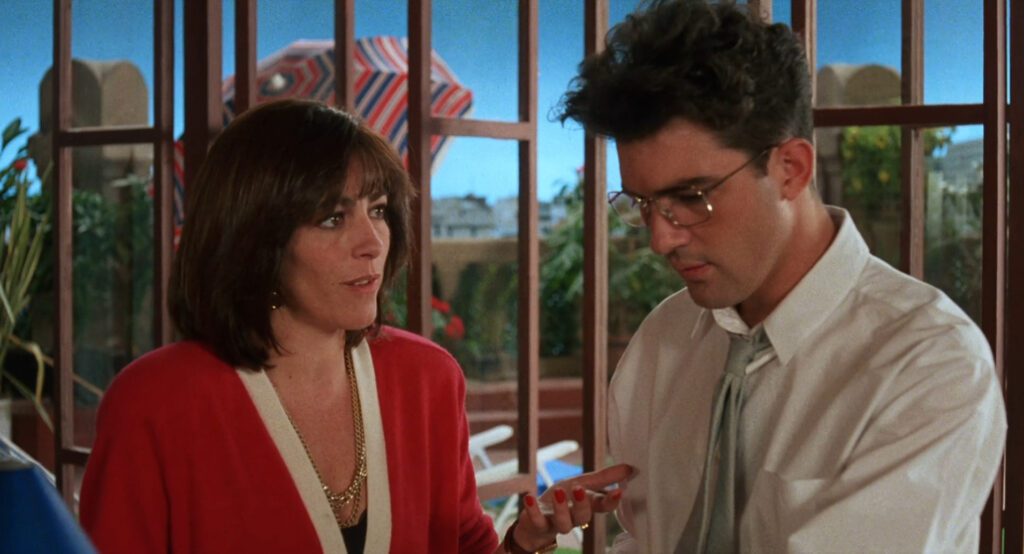
Women on the Verge of a Nervous Breakdown
1988, directed by Pedro Almodóvar
The opening titles of Women on the Verge of a Nervous Breakdown are 21 shots in the style of a collage, mostly of women’s body parts – eyes, mouths, legs, hands, parts of faces, also shoes and jewelry. Disembodied red lips are arranged like flowers and butterflies. The collage emphasizes the separateness of these parts, and one frame shows a pair of scissors cutting apart a strip of eyes. Only two of the last frames, the 17th and the 21st, which credit the composer and director alongside the apparatuses of music and filming, show women whole. Taken together, the series insinuates that the movie will eventually bring its characters to wholeness. Their division, up until then, accounts for the “ataque de nervios” in the title.
In Spanish, “ataque de nervios” is not exactly a “nervous breakdown” as the English title puts it, but rather “hysteria” in the sense of 19th century psychiatry. In psychoanalytic theory there are many ways a person might fall short of wholeness, not least of all in the sense of the Lacanian “split subject”. The opening titles suggest a more literal sense. All the body parts are like the fetish objects of men who see women in pieces, like objects for consumption – a point of view that a woman may well internalize in response. Additionally, the protagonist Pepa works as an actress, the mother of a serial killer on a television show – and as Ingmar Bergman’s Persona puts it so clearly, a performer can feel split between her own identity and her stage persona.
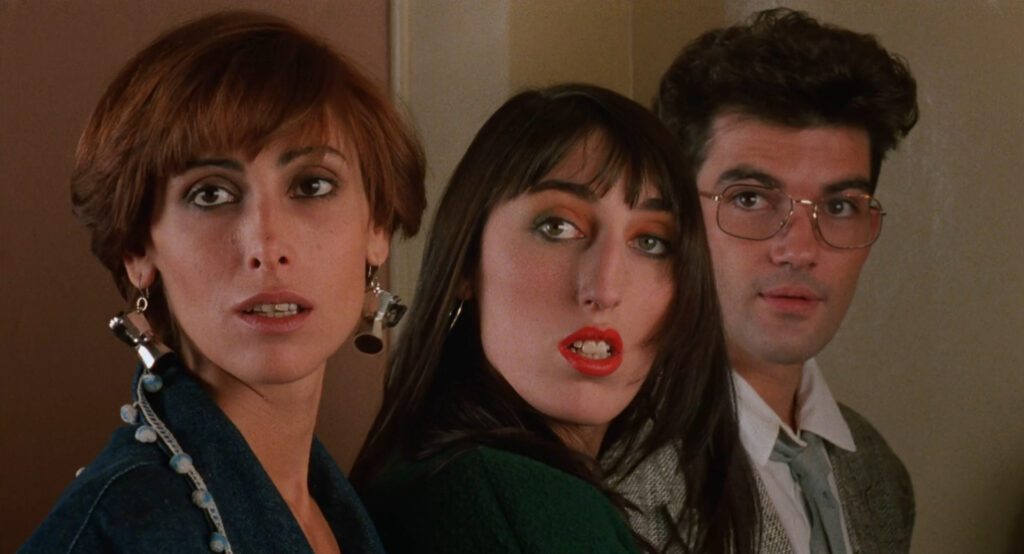
There are many ways to construe the idea of the “divided woman”, many of which are surely applicable here and compatible with each other, but in the opening scenes Pepa helps us to clarify this complex question. Describing her efforts to create a “Noah’s Ark” on her terrace, she says: “I wanted to save a couple of every kind of animal. In any case, I didn’t manage to save the couple I cared about most. Mine.”
There’s nothing about trying to save a relationship that necessarily makes a person incomplete, but what distinguishes Pepa’s story is its ending. Despite Iván’s infidelities, all the pieces are in place for Pepa to reconcile with him, yet she declines to do so. He evidently still loves her; she’s saved his life; he’s publicly chosen her over Paulina; and she still cares for him. Nevertheless, in their parting words, he asks why she came out to the airport, and she says it was only to save him from danger, and that she’ll leave now without him. She’s learned, in the course of everything we’ve seen, to see herself as sufficient. She no longer needs a man in order to feel complete.
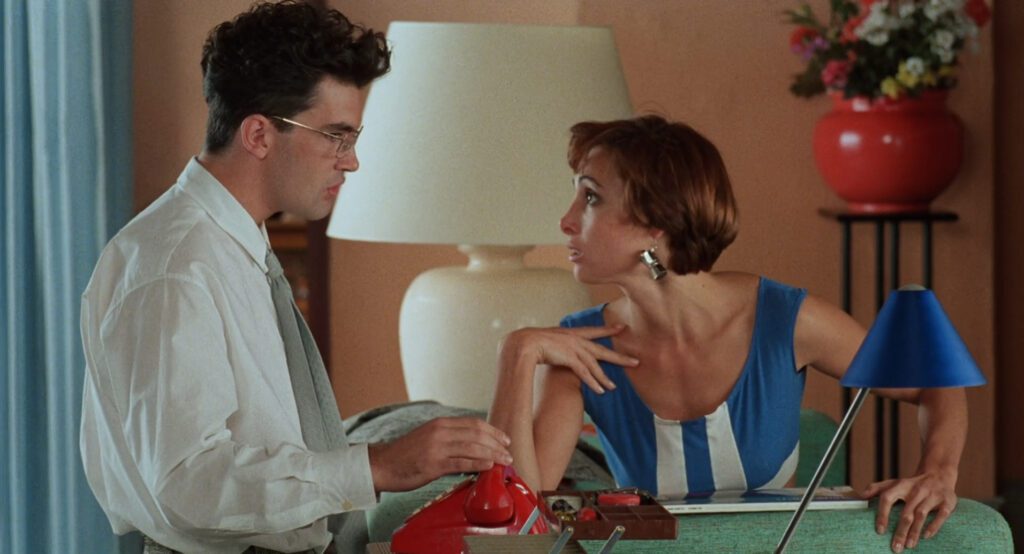
In a traditional Catholic society like Spain, only twelve years after the end of Franco’s rule, there was surely a degree of heresy in such a radical assertion of a woman’s independence. Given the same plot, a conventional popular movie would have reunited Pepa and Iván, celebrating her forgiveness and his repentance – but Women on the Verge means to overthrow this traditional order. More than that, it means to overthrow the assumptions on which that patriarchal order rests.
A conventional drama, of course, would focus on a married couple or a couple who might get married. This movie is all the more subversive for omitting almost any question of marriage between the characters. Pepa and Iván have been living together “in sin”, and there’s no mention of prior marriage to Lucía, the mother of Iván’s son Carlos. Marisa and Carlos are engaged, but that bond dissolves without friction when Carlos meets Candela. The only mention of marriage, or of the words “wife” or “husband”, is in a fictional wedding at the film studio, a comic vignette that mocks the institution’s bias toward the man. Instead of saying “I do” the groom says, “Yeah, I think so,” and the bride says, “Sure, of course I do,” then the priest tells the bride not to trust any man, even her husband.
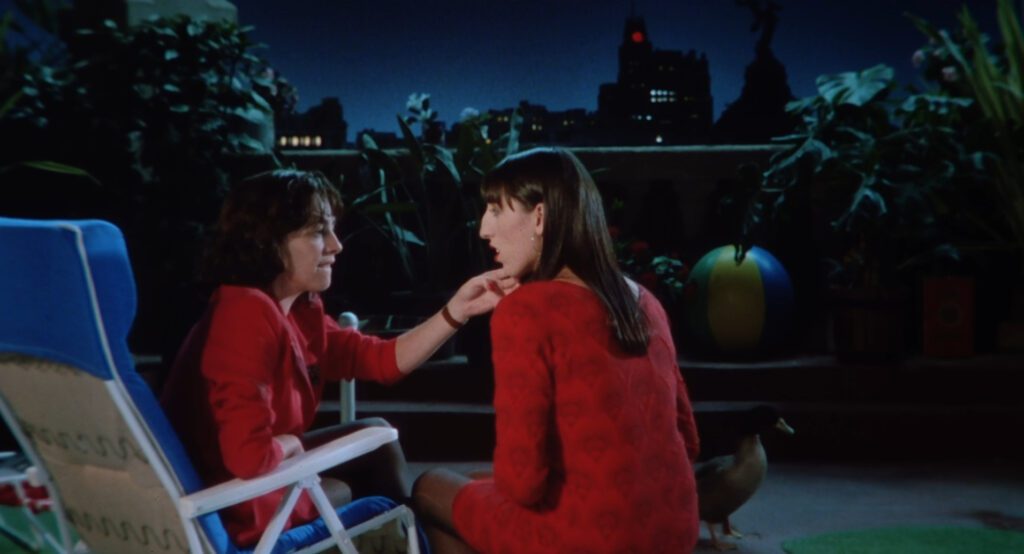
For all the heresy in the idea that a woman doesn’t need a man, there’s a seemingly opposite heresy at the very end. Marisa wakes up from her morphine-induced sleep with a memory of sexual satisfaction in her dream. She confesses the experience to Pepa, who sympathizes. “You’ve lost that hard look virgins usually have. Virgins are awful.” Those are the movie’s last lines, and there’s a double irony in them. A conservative religious culture typically prizes female virginity as a sign of virtue, and Pepa turns that value on its head, but in doing so it would seem that she backtracks on the previous point. If being a virgin is awful, doesn’t that make a man necessary? – except that, no, Marisa has lost the stigma of virginity without a man. One could imagine other ways, but the movie feels no need to get graphic about it.


Marisa’s life-altering dream was the result of gazpacho laced with sleeping pills. The pitcher of gazpacho is a key image, lasting exactly 59 minutes of screen time from Pepa’s preparation to Lucía throwing it in Pepa’s face. The famous Andalusian tomato soup represents traditional Spain, both in real life and in the film’s argument. Pepa draws blood while making it, just as any Spanish woman will suffer for the country’s traditions. She puts morphine in it, the same way a woman might conform to tradition to lull men (or other adversaries) into complacency. When the policeman, slipping under the soup’s spell, asks “What’s in the gazpacho?” Pepa willfully misinterprets the question:
“Tomato, cucumber, pepper, onion, one clove of garlic, oil, salt, vinegar, dry bread, and water. The secret’s in the mixing. Iván loved the way I made it. I made it for him.”
She doesn’t mention the sleeping pills, but in a sense they were always part of the recipe. For much of history women could only get their way under the cloak of tradition.
If Pepa and Iván, in that sense, are a typical Spanish couple, then Iván’s ex, Lucía, in her nastiness and madness, is like the fascist government that Spain had embraced a few years back. Lucía confronts Pepa with a revolver in one hand and a glass of gazpacho in the other, just as Franco had ruled Spain with a combination of force and tradition. (She steals the revolvers from the sleeping policemen, as Franco’s power was also stolen from the Spanish people.) Asserting her rights to Iván, she throws the gazpacho in Pepa’s face in the way that conservatives throw tradition in people’s faces. Pepa, Candela, and Marisa are modern women, and the movie is a portrait of Spain emerging from the grip of Franco on its way to becoming one of the most liberal countries of the 21st century. The women’s sense of being torn in pieces is, among other things, a function of the hysteria imposed on them for so many decades.
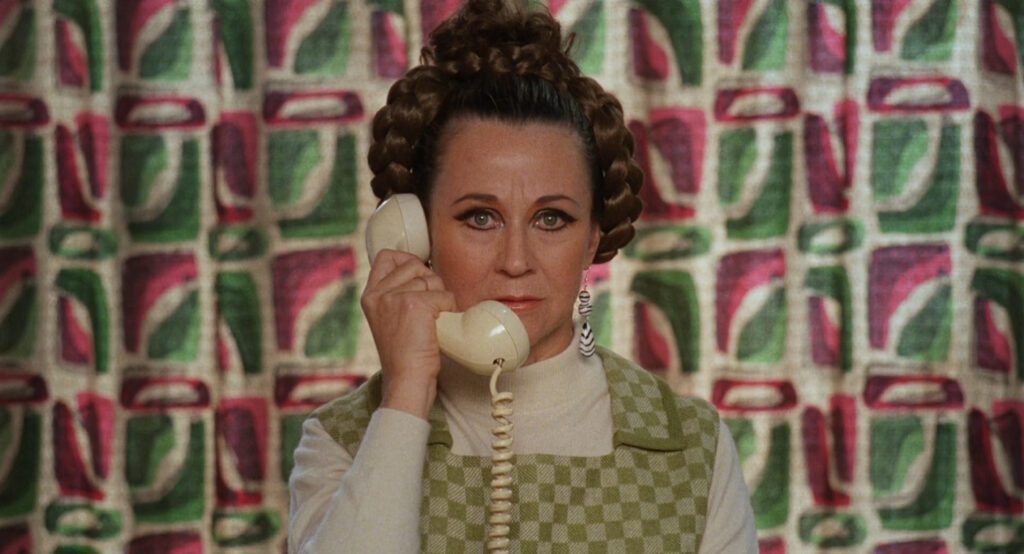
There’s another important way that Pepa might feel split as a person. Ever since her visit to the doctor seven minutes into the film, she’s known that she’s pregnant. Apart from the sense of being two persons in one, the prospect of becoming a single mother in a traditional society must add to the stresses pushing her to hysteria. Pepa’s evident acceptance of her pregnancy is a way of reclaiming the biological fact of motherhood from the dominion of the traditional family structure with all of its surplus demands and unwanted power relations.
Women on the Verge of a Nervous Breakdown ends on a note of liberation, but it’s not solely a sexual or political liberation. One funny but meaningful sign of Pepa’s hysteria is her bedside table with no fewer than four alarm clocks side by side. For someone lacking the inner peace that comes with a sense of wholeness, time itself can feel oppressive. The movie is full of telephones, which are like surrogate clocks, always ringing and interrupting the flow of life, bringing stress every time they appear. In the final scene, chatting on the terrace with Marisa while everyone else sleeps, Pepa’s sense of time must feel different. She thinks of the baby in her womb, and instead of feeling split in two, she sees herself within a larger continuum of life.
CONNECTIONS:
Rear Window – Protagonist witnesses a spectrum of behaviors and emotions, including crying and dancing, in the windows of a city block
Persona – Women who feel split in two, both as actresses and as mothers
The Bitter Tears of Petra von Kant – Agony of waiting for a phone call
Cries and Whispers – Series of clocks at the beginning gives way to a less oppressive view of time at the end
Run Lola Run – Telephone as a surrogate clock